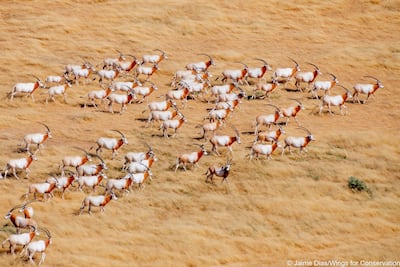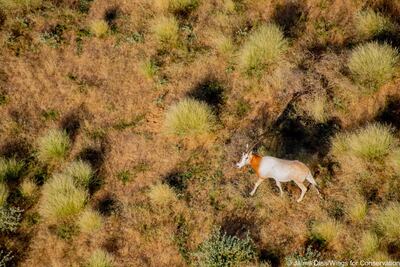Environment Agency Abu Dhabi has completed its mission to relocate 25 scimitar-horned oryxes and 25 addax antelopes to Chad.
It plans to send another 25 oryxes in February and all of the animals will be released into the wild.
The programme is part of one of the world’s largest reintroduction programmes.
Launched in 2014, it is intended to create a self-sustaining herd of more than 500 scimitar-horned oryxes in the Ouadi Rimé-Ouadi Achim Wildlife Reserve, which occupies 77,950 square kilometres.

In 2000, the species was declared extinct in the wild by the International Union for the Conservation of Nature.
The first ones to be relocated were released into the wild in 2016 and have adapted well to their surroundings.
In 2017, another heard of 75 scimitar-horned oryxes arrived in an operation led by Chad’s Ministry of Environment and Fisheries and the Sahara Conservation Fund.
This year, 60 new calves have been born, bringing the number in the wild to about 400.
This particular breed of oryx can survive for months or even years without drinking water. A grazing animal, it derives most of its daily moisture intake from plants.
The second phase of the programme concerns the critically endangered addax.
This arid-land antelope is very well adapted to living in the Sahara, and rarely needs to drink water to survive. But its impressive horns, meat and hide are attractive to poachers, and the animal’s population has plummeted during the past century.
The first group, of 15 animals, was reintroduced in 2019, followed by 25 in 2020. Fifteen calves were born this year.

“We will always continue the legacy of the late Sheikh Zayed, who pioneered the SHO reintroduction programme, the first of its kind anywhere in the world,” said Dr Shaikha Al Dhaheri, secretary general of Environment Agency Abu Dhabi.
“It is saddening to see species becoming extinct and we at EAD [the agency] will do everything in our capacity to reverse this.”
Environment Agency Abu Dhabi has darted 18 wild scimitar-horned oryxes and fitted them with satellite tracking collars. This has enabled the agency to monitor the species behaviour, including reproduction.
“Next month, we will be releasing both scimitar-horned oryxes and addaxes in Chad in collaboration with our partners, who are truly invested in ensuring the project’s success, and we are on track to establish a herd of 500 of the oryxes in the wild.
“Our efforts will continue next year, and we are expecting the birth of more calves, which will help to increase herd sizes and curb the rapid decline of these species.”
Sheikh Zayed, the Founding Father, first noticed the rapid decline of scimitar-horned oryxes in the wild during the 1960s.
He ordered the creation of a captive breeding programme, to be piloted in the UAE. The animals were housed on Sir Bani Yas Island, where their number eventually exceeded 1,000.
Their conservation is supported by several prominent global partners, including Chad’s Ministry of Environment, the EU, the Sahara Conservation Fund, the Zoological Society of London, the Smithsonian Conservation Biology Institute, Marwell Wildlife, Royal Zoological Society of Scotland, Saint Louis Zoo WildCare Institute and Fossil Rim Wildlife Centre.












